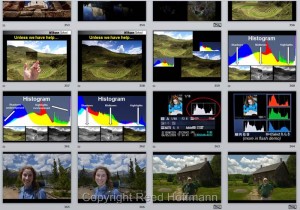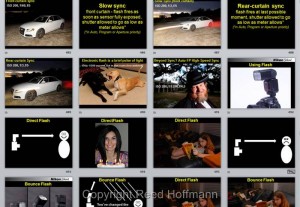Most of my work these days involves teaching. And I’ve learned that no matter how much I think I know about photography, there’s always more to learn. You see, I spent 25 years taking pictures before I really understood what was behind much of that photography. And that’s changed both how I shoot pictures, as well as how I teach photography. I’ve been thinking about that a lot the last few weeks as I re-write the curriculum for Nikon School, which I’ve been teaching for the last ten years.
For example, anybody who’s into photography knows the words “aperture,” “diaphragm” and “f/stop.” But do you know that these are three different things? “Aperture” is the physical hole in the lens that light passes through. “Diaphragm” is how that hole is created, usually by thin blades of metal that
can be adjusted to make the hole larger and smaller. And “f/stop,” one of the trinity of exposure (ISO, Shutter Speed and Aperture), is a mathematical calculation of the amount of light that reaches the sensor through the lens. Think about that for a minute. It means that f/5.6 is a different-sized aperture (hole) in a 300mm lens than it is in a 35mm lens. Why? Because a 300mm lens is much longer than a 35mm, so light has to travel a longer distance through that lens barrel, losing some of its power in the process. So the “aperture,” that hole in the lens, has to be larger in the 300mm lens to let the same amount (f/5.6) of light into the camera than the 35mm can since it’s much shorter. F/stop is calculated by taking the focal length of the lens and dividing it by the size of the aperture. So lenses that maintain the same f/stop while zooming (a 70-200mm f/2.8 for instance) are able to do that by changing the aperture as you zoom to telephoto, making the aperture larger. And zoom lenses whose f/stop decreases as you
zoom (from f/3.5 to f/5.6 for instance) have an aperture that stays the same size while zooming. I think that’s fascinating.
Or let’s think about flash. Most people know that cameras have a “sync” speed that limits how high a shutter speed their camera can use when working with an electronic flash (a “speedlight,” if you will). That’s normally around 1/200 second. Do you know why? It has to do with the design of the shutter. Today’s SLR’s use a two-curtain shutter. The shutter sync is the highest speed that shutter can fire and still have the entire sensor exposed at the same time. At higher shutter speeds, the second curtain is starting to cover the sensor before the first has reached the top. To make things even more interesting, many cameras now have a high-speed sync mode (“Auto FP” on Nikon) that lets you break that limit- essentially by turning your flash into a very fast strobe light. Did you realize our flashes normally

Some of the slides used in the conversation about the qualities of light in this year’s Nikon School programs.
fire between 1/1000-1/20,000 second? Cool!
These are just two of the topics that I’ve enjoyed learning about, and now teach. Because the more you learn about how your gear works, the more creative (and successful) you can be. I’ve always said that one of the great things about photography as a hobby is that the directions you can go with it are almost endless. And that’s true of learning about it too.
As much as I enjoy the techy stuff, I also know that most people are simply looking to make better pictures. Aren’t we all? So do you know why sidelight is often more interesting than frontlight? It adds depth to a two-dimensional picture, brings out texture in objects and creates patterns of light and shadow. And that wide-angle shots better when you take advantage of both foreground and background elements? I

Nikon School offers an introductory Saturday class, an advanced Sunday class, a two-day video class and an online Capture NX 2 class.
used these techniques and many others for over twenty years as a working photographer, but only in the last ten have I really learned why they’re so important and effective, and how to help other people take advantage of them.
I’m happy to admit I don’t know everything. Wouldn’t life be boring if you did? That’s one reason I love teaching workshops – because I always learn something too. Recently I had a student ask about using Auto ISO when in Manual exposure mode. What a great idea! I’d never thought of that. And last week I wrote about the video workshop I just took part in, which was another great learning opportunity for me.
So do yourself a favor and take advantage of any workshops you can. Attend a lecture, or a shooting workshop (like Mentor Series, of some of the others I teach), or join me and the other instructors at one of the 27 Nikon Schools we’ll be teaching around the country starting this October. We’ll have a great time learning together!



